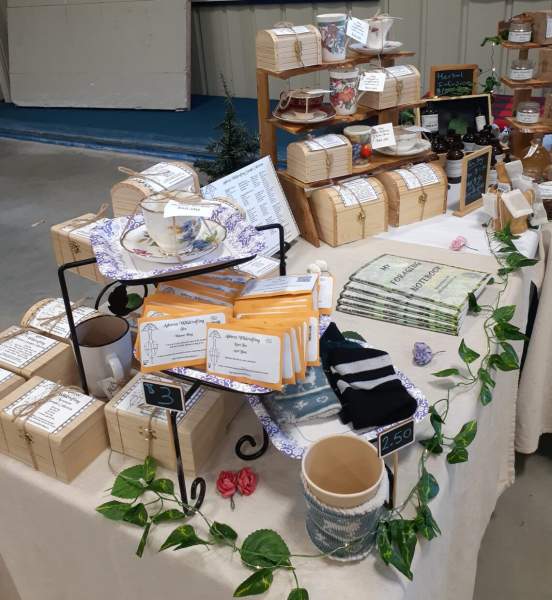Stay up to date on what I share on my blog, Scripture quotes, news as it pertains to staying healthy, body, soul and spirit, etc.

Sitting here exhausted, but very pleased with today's foraging run! The highlight of today's outing was actually catching harvest season for the wild strawberry for the first time in years!
This weekend, we are at Schubert Centre for their summer market, then we are back at the Rutland Flea Market. We've purchased a 4ft folding table that we hope will be big enough to handle a tighter version of the layout we had at Lumby Days. The Lumby Days Indoor Craft Fair blew our socks off!
The way the Lumby Days booth setup looked, we are becoming a veritable roving wildcrafted tea parlor with a side of medical insight to help people make choices that benefit their situations. Several times so far this spring, and several times at both major fairs this month, we've been asked if we have a storefront. As of yet, we do not, but we realize that if sales continue as they are, we will be in need of more processing space that can allow for a foodsafe kitchen, processing area, and expanded drying area so we can expand available quantities of the teas we offer, and potentially branch into other wildcrafted goods for sale.
If you are reading this and you are in the Central Okanagan region, and if you believe you know someone who might help in some way, drop us a line with that information.
https://naturalhealthgodsway.c....a/2025/06/18/foragin
From wild-herbed tea blends selling more than ever anticipated, to my daughter having earned her Chartered Herbalist certificate, and trying to harvest what we can in a bid to have stock over the winter and non-harvesting months (before the herbs we use are ready to harvest), life has gone a little crazy! Here is an update from my daughter's tea shop:
https://ashtreewildcrafting.ca..../wp/blog/2025/06/16/
Time for an update! 2025 continues it's crazy trajectory and we've now hit full throttle!
People continue to hint at me writing books about our wild food and medicine escapades. The textbook idea is taking shape, and I've decided the herbal compendium will be a trip through history as we follow herbal medicine as far back as we can. Currently, that promises to be a food and medicine list of at least 217 foods, herbs and spices, just under half the current number of plants in my nutrtional/medicinal wholefood database.
Just today, someone hoped my foraging notebook had more in it than just the basics of how to forage for wild foods. So I may take parts of my "textbook" and build both a "herbs in the Central Okanagan" book, and either share in it or share in yet another book, the experiences we've had with using wild herbs as our pharmacy at home.
ANNOUNCEMENT TO CENTRAL OKANAGANITES!!!
The Advanced Foraging Workshop: Thistle Dip and Breaded Thistle spears, is coming up June 28th and we have two people already registered! The last day to register is June 7th. For those who like to pay in person, come see us at Booth 105 in the Vernon Rec Centre in the hallway between the Auditorium and the gym.
If you want to catch us in person before Creative Chaos, come to see us at the Rutland Flea Market on June 1st.
https://naturalhealthgodsway.c....a/2025/05/25/book-fa
We are a couple days away from the Arrowleaf Balsamroot Advanced Foraging Workshop on Saturday. Registration closed for this one back on May 3rd.
The next Advanced Foraging Workshop is June 28th, and will cover making yummy foods with the flower buds of Canada Thistle, and the leaf ribs of Scotch Thistle. Right now, early registrants for the Thistle workshop are in Vernon. As I do not know the trails around Vernon very well, I am open to anyone telling me where they've seen both canada Thistle and Scotch or Bull Thistle on public-use land.
Foraging has exploded this year. We are seeing evidence of other foragers, so for those reading this who also forage, remember the 5% rule! Never take more than 5% of any given patch so that animals and people coming behind you can avail themselves of the abundance too.
The textbook-writing idea is slowly taking shape. I've come to the conclusion that we are not traditional herbalists, we are phytotherapeutic herbalists! As I start writing my textbook dig up research to confirm what I want to say and verify or add to it, discovering why colleges teach backward herbalism, labelling it as Traditional, is a slap in the face and explains why so many believers are so wary of anyone who claims to be a Christian AND claims to be a herbalist or healer. My textbook will teach a version of Western Herbalism I am terming: The Phytotherapeutic Herbalist! The working title for the book is A Christian Perspective on Western Herbalism.
If you know people who would like to be kept in the loop about this book, tell them to register for this newsletter. They can visit the site to do that, or you can forward my newsletter emails to them and they can respond asking to register for the newsletter.
https://naturalhealthgodsway.c....a/2025/05/15/foragin
This devotional article just got a major update thanks to recent information shared by Faithwire Magazine! It would appear that biophotonics begin at conception and carry straight through to death of the body. We look at additional Scripture as well, that Faithwire offered as suggested reading.
https://naturalhealthgodsway.c....a/2024/02/17/is-your





